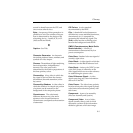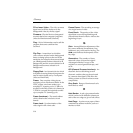
G-7
Glossary
Hard Disk: An electronic device which is
capable of storing large amounts of data
and programs for retrieval and use by a
computer. (Also see Floppy Disk.)
Hardware: The electric, electronic, and
mechanical equipment used to perform
the tasks controlled by a computer. (Also
see Firmware and Software).
Head: An electromagnetic device that
reads, writes, or erases information in a
storage medium.
Hex (hexidecimal): A numerical
notation system using a base of 16. (Also
see Binary and Octal).
House Sync: The synchronous signal
generated in the studio for use as a
reference for other timing signals.
Hue: The attribute of light (wavelength,
frequency) which determines the color
perceived (red, blue, green etc). Specified
by phase relationship to color burst in
composite video. Any saturated color
which is not one of the three primaries
may be treated as a combination of two
primaries.
I
Insert Key: A key in which a portion of
the background signal is replaced with an
insert (fill) signal.
Interrupt: A special control signal which
informs the CPU that its attention is
needed for some type of exception
processing.
J
Jog: The process of moving a videotape
forward or backward at a variable rate of
speed.
K
Key: (1) An effect in which a portion of
the background video picture is replaced
by another picture or caption (2) The
signal which is used to pass or block
portions of the background and fill video
signals.
Keyboard: A small control panel with
pushbutton keys that provides the human
interface into an electronics system.
Key Fill: In a key effect, the video signal
that is said to “fill the hole” cut in
background video by the key source. Key
fill may be key video, modified key video,
or matte.
Key Invert: (1) A key mode which inverts
the polarity of the key to allow dark areas
of the source video to cut holes in
background. (2) A chroma key mode
which inverts the foreground and
background fill positions.
Key Source: The source of the signal
which is said to “cut the hole” in the
background scene for a key effect. This
signal is processed into a key which
controls the video mix between the
background scene and the fill video; thus
the key source determines the shape of the
key effect.


















